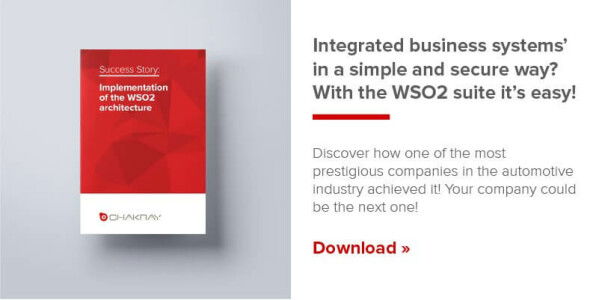In all types of organizations, but especially in those that integrate several work teams and manage numerous operations with data and information on a day-to-day basis, communication between different kinds of software has become a growing need. And, in many cases, an inconvenience that needs to be solved.
A middleware is precisely the tool that can make different types of software that do not use the same language capable of communicating with each other. The middleware contributes to make sharing information between systems easy and fast, regardless of the devices you work with, their software, the localization or the moment in which that communication takes place.
Thanks to this type of tool, the development of new applications allows a company to find new solutions to the needs it detects, since middleware technologies are able to scale and adapt to changes. Otherwise, it would be necessary to generate tailor-made solutions that would not only cause delays in the projects but would also force them to incur a high economic cost and the consequent delays in terms of time.
What is WSO2 Middleware?
The middleware produced by WSO2, the Californian company that develops open software applications, is the only one with these features, and it is also ready to work in the cloud. This makes it unique in today’s market as it is completely scalable, meaning that it can be used, customized and optimized constantly, in numerous environments and with rapid development. WSO2 middleware gives the organization that uses it complete control over the management of its information and the way its different departments and software communicate. Not only that, but it is also possible to manage the middleware architecture to adapt it to specific requirements according to the work carried out by the developers.
WSO2 middleware enables close collaboration between product developers and other departments, enabling software products to reach the market more quickly. Moreover, it encourages learning in on-demand environments, with information in the cloud that can be shared transparently and securely.
WSO2 Platform
WSO2 provides organizations that use data with unprecedented flexibility to deploy their functionality. This is the case of the WSO2 Platform, which has an advantageous design that allows working with data both from the installations themselves and from accessing the cloud. In this way, it adapts to the demands presented by each company and its IT projects.
Built on the OSGi specification, WSO2 Carbon –the technology on which all WSO2 products are built– allows developers to easily deploy and customize any of their middleware products, as well as the more than 175 components that compose them, providing greater flexibility and agility to meet the changing demands of the company.
The WSO2 platform is made up of different components that offer a variety of functions: WS02 Application Server, WS02 Enterprise Service Bus, WSO2 Business Process Server, WSO2 Business Activity Monitor, WSO2 Complex Event Processor, WSO2 Data Services Server, WSO2 API Manager, WSO2 Identity Manager.
A Flexible & Scalable Architecture
The specific end-to-end solutions provided by the WSO2 Platform are useful for many sectors, such as finance, retail, health or education, to name but a few. This platform is able to contribute to the development of a flexible architecture, which allows innovation and management of large volumes of data. It is also capable of enabling and linking a wide variety of applications, which, although using disparate systems, do not cause any inefficiencies or impediments. What is more, it is able to facilitate the management of APIS with which to access customers by connecting order management systems. In areas related to private and sensitive data, such as the use of data by government agencies, it provides extra security and confidentiality.
WSO2 is the most experienced and efficient middleware company on the market, as evidenced by the results of organizations that rely on it and by the fact that its solutions are used in a growing number of industries. Its open-source, conceived and designed to ensure further development and flexibility in its architecture, both in-house and internally, as well as in the cloud, represents a competitive advantage both in the short and long term.





